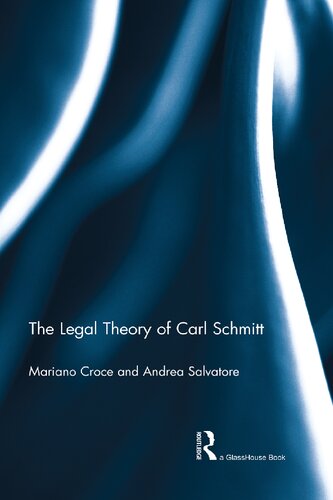The Legal Theory of Carl Schmitt 1st Edition by Mariano Croce, Andrea Salvatore 1138780847 9781138780842
$50.00 Original price was: $50.00.$35.00Current price is: $35.00.
The Legal Theory of Carl Schmitt 1st Edition by Mariano Croce, Andrea Salvatore – Ebook PDF Instant Download/Delivery: 1138780847, 9781138780842
Full download The Legal Theory of Carl Schmitt 1st Edition after payment

Product details:
ISBN 10: 1138780847
ISBN 13: 9781138780842
Author: Mariano Croce, Andrea Salvatore
The Legal Theory of Carl Schmitt provides a detailed analysis of Schmitt’s institutional theory of law, mainly developed in the books published between the end of the 1920s and the beginning of the 1930s. By reading Schmitt’s overall work through the lens of his institutional turn, the authors offer a strikingly different interpretation of Schmitt’s theory of politics, law and the relation between these two domains. The book argues that Schmitt’s adhesion to legal institutionalism was a key theoretical achievement, based on serious reconsideration of the main flaws of his own decisionist paradigm, in the light of the French and Italian institutional theories of law. In so doing, the authors elucidate how Schmitt was able to unravel many of the impasses that affected his previous conceptual framework. The authors also make comparisons between Schmitt and other leading legal theorists (H. Kelsen, M. Hauriou, S. Romano and C. Mortati) and explain why the current legal debate should take into serious account his legacy.
The Legal Theory of Carl Schmitt 1st Table of contents:
Part I Concepts: decision, institutions and concrete order
Chapter 1 The bumpy road to institutionalism: Schmitt’s way-out of decisionism
1.1 Preliminary
1.2 The borderline concept of exception as a boundary marker of the concept of law
1.3 Grounding law: the evident inadequacy of the normativist approach
1.4 Grounding law: the hidden inadequacy of the decisionist solution
1.5 Opening up to community: the gradual turn to social practices
Chapter 2 Exploring Schmitt’s institutionalism: institutions and normality
2.1 Preliminary
2.2 On the Three Types of Juristic Thought: a political vs. a jurisprudential interpretation
2.3 Norms, normality and social reality
2.4 Institutions as social products
2.5 The core nature of social reality
Chapter 3 Institutionalist decisionism: law as the shelter of society
3.1 Preliminary
3.2 Pluralist institutionalism vs. decisionist institutionalism
3.3 Why an institutional view of law? Schmitt and pluralism
3.4 Institutionalist decisionism at work: the role of general clauses
3.5 Law, normality and the leader
Chapter 4 Institution and identity: reassessing Schmitt’s political theory
4.1 Preliminary
4.2 Defining between opposition and determination: the quest for a positive content
4.3 The Concept of the Political: An enemy without enemies
4.4 Constitutional Theory: A non-constituting constitution
4.5 Carrying institutionalism to the extreme: Schmitt between concrete order and total state
Part II Oppositions: his ‘enemies’ and ‘friends’
Chapter 5 Schmitt vs. Kelsen: the social ontology of legal life
5.1 Preliminary
5.2 A brief outlook on Kelsen’s ‘Pure Theory of Law’
5.3 Schmitt’s criticisms of Kelsen’s positivism: legal theory or social ontology?
5.4 Legal theory and the nature of law
Chapter 6 Schmitt vs. Hauriou: the politicization of institutionalism
6.1 Preliminary
6.2 Schmitt’s references to Hauriou’s works
6.3 An overview of the legal theory of Maurice Hauriou
6.4 The Schmittian interpretation of Hauriou’s institutionalism: sound reasons and misleading twists
6.5 Capitalizing on Hauriou’s legacy: the uncodifiable legitimacy of customary practices
Chapter 7 Schmitt vs. Romano: institutionalism without pluralism
7.1 Preliminary
7.2 Santi Romano’s social ontology: the notion of institution
7.3 Legal pluralism and Romano’s dilemma
7.4 Institutionalisms compared: institution, legal realm and pluralism
7.5 (Schmitt’s) Romano against (Romano’s) Romano?
Chapter 8 Schmitt vs. Mortati: the concretization of the concrete order
8.1 Preliminary
8.2 The concept of material constitution
8.3 The quest for the original source of law: Mortati as a reader of Schmitt
8.4 General clauses, state of exception, political enmity: rejoining law and politics
8.5 Janus revised: the converging faces of the concrete constitution and the legal order
Part III Implications: Schmitt’s institutionalism and the current legal debate
Chapter 9 The impossibility of legal indeterminacy
9.1 Preliminary
9.2 An indeterminate concept: What is legal indeterminacy?
9.3 The haunting problem of legal indeterminacy: Law and Judgment
9.4 The dark solution: State, Movement, People
9.5 The failure and the legacy
Chapter 10 The inconceivability of legal pluralism
10.1 Preliminary
10.2 From social to legal pluralism
10.3 Social and political consequences of today’s legal pluralism
10.4 Pluralism in Schmittian lenses: social, not legal
10.5 Schmitt’s solution: the principle of homogeneity
Notes
1 The bumpy road to institutionalism: Schmitt’s way-out of decisionism
2 Exploring Schmitt’s institutionalism: institutions and normality
3 Institutionalist decisionism: law as the shelter of society
4 Institution and identity: reassessing Schmitt’s political theory
5 Schmitt vs. Kelsen: the social ontology of legal life
6 Schmitt vs. Hauriou: the politicization of institutionalism
7 Schmitt vs. Romano: institutionalism without pluralism?
8 Schmitt vs. Mortati: the concretization of the concrete order
9 The impossibility of legal indeterminacy
10 The inconceivability of legal pluralism
People also search for The Legal Theory of Carl Schmitt 1st:
the legal theory of carl schmitt
carl schmitt legality and legitimacy
carl schmitt’s early legal-theoretical writings
carl schmitt constitutional theory
Tags: Mariano Croce, Andrea Salvatore, Theory, Schmitt



